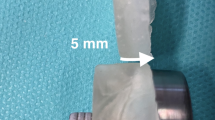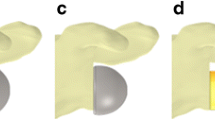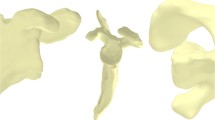Abstract
Introduction
The aim of this study was to investigate the stabilizing influence of the rotator cuff as well as the importance of glenosphere and onlay configuration on the anterior stability of the reverse total shoulder replacement (RTSR).
Materials and methods
A reverse total shoulder replacement was implanted into eight human cadaveric shoulders, and biomechanical testing was performed under three conditions: after implantation of the RTSR, after additional dissection of the subscapularis tendon, and after additional dissection of the infraspinatus and teres minor tendon. Testing was performed in 30° of abduction and three rotational positions: 30° internal rotation, neutral rotation, and 30° external rotation. Furthermore, the 38-mm and 42-mm glenospheres were tested in combination with a standard and a high-mobility humeral onlay. A gradually increased force was applied to the glenohumeral joint in anterior direction until the RTSR dislocated.
Results
The 42-mm glenosphere showed superior stability compared with the 38-mm glenosphere. The standard humeral onlay required significantly higher anterior dislocation forces than the more shallow high-mobility onlay. External rotation was the most stable position. Furthermore, isolated detachment of the subscapularis and combined dissection of the infraspinatus, teres minor, and subscapularis tendon increased anterior instability.
Conclusions
This study showed superior stability with the 42-mm glenosphere and the more conforming standard onlay. External rotation was the most stable position. Detachment of the subscapularis as well as dissection of the complete rotator cuff decreased anterior stability.





Similar content being viewed by others
References
Edwards TB, Williams MD, Labriola JE et al (2009) Subscapularis insufficiency and the risk of shoulder dislocation after reverse shoulder arthroplasty. J Shoulder Elbow Surg 18:892–896. doi:10.1016/j.jse.2008.12.013
Grammont PM, Baulot E (1993) Delta shoulder prosthesis for rotator cuff rupture. Orthopedics 16:65–68
Boileau P, Watkinson D, Hatzidakis AM, Hovorka I (2006) Neer Award 2005: the Grammont reverse shoulder prosthesis: results in cuff tear arthritis, fracture sequelae, and revision arthroplasty. J Shoulder Elbow Surg 15:527–540. doi:10.1016/j.jse.2006.01.003
Boileau P, Watkinson DJ, Hatzidakis AM, Balg F (2005) Grammont reverse prosthesis: design, rationale, and biomechanics. J Shoulder Elbow Surg 14:S147–S161. doi:10.1016/j.jse.2004.10.006
Bufquin T, Hersan A, Hubert L, Massin P (2007) Reverse shoulder arthroplasty for the treatment of three- and four-part fractures of the proximal humerus in the elderly. A prospective review of 43 cases with a short-term follow-up. J Bone Joint Surg Br 89-B:516–520. doi:10.1302/0301-620X.89B4.18435
Cuff D, Pupello D, Virani N et al (2008) Reverse shoulder arthroplasty for the treatment of rotator cuff deficiency. J Bone Jt Surg 90:1244–1251. doi:10.2106/JBJS.G.00775
Gallinet D, Clappaz P, Garbuio P et al (2009) Three or four parts complex proximal humerus fractures: hemiarthroplasty versus reverse prosthesis: a comparative study of 40 cases. Orthop Traumatol Surg Res 95:48–55. doi:10.1016/j.otsr.2008.09.002
Grassi FA, Murena L, Valli F, Alberio R (2009) Six-year experience with the Delta III reverse shoulder prosthesis. J Orthop Surg Hong Kong 17:151–156
Levy JC, Virani N, Pupello D, Frankle M (2007) Use of the reverse shoulder prosthesis for the treatment of failed hemiarthroplasty in patients with glenohumeral arthritis and rotator cuff deficiency. J Bone Joint Surg Br 89-B:189–195. doi:10.1302/0301-620X.89B2.18161
Levy J, Frankle M, Mighell M, Pupello D (2007) The use of the reverse shoulder prosthesis for the treatment of failed hemiarthroplasty for proximal humeral fracture. J Bone Jt Surg 89:292–300. doi:10.2106/JBJS.E.01310
Matsen FA, Boileau P, Walch G et al (2007) The reverse total shoulder arthroplasty. J Bone Jt Surg 89:660–667
Rittmeister M, Kerschbaumer F (2001) Grammont reverse total shoulder arthroplasty in patients with rheumatoid arthritis and nonreconstructible rotator cuff lesions. J Shoulder Elbow Surg 10:17–22. doi:10.1067/mse.2001.110515
Wall B, Nové-Josserand L, O’Connor DP et al (2007) Reverse total shoulder arthroplasty: a review of results according to etiology. J Bone Jt Surg 89:1476–1485. doi:10.2106/JBJS.F.00666
Young SW, Everts NM, Ball CM et al (2009) The SMR reverse shoulder prosthesis in the treatment of cuff-deficient shoulder conditions. J Shoulder Elbow Surg 18:622–626. doi:10.1016/j.jse.2009.01.017
Frankle M, Siegal S, Pupello D et al (2005) The reverse shoulder prosthesis for glenohumeral arthritis associated with severe rotator cuff deficiency. J Bone Jt Surg 87:1697–1705. doi:10.2106/JBJS.D.02813
Guery J, Favard L, Sirveaux F et al (2006) Reverse total shoulder arthroplasty. J Bone Jt Surg 88:1742–1747. doi:10.2106/JBJS.E.00851
Werner CML, Steinmann PA, Gilbart M, Gerber C (2005) Treatment of painful pseudoparesis due to irreparable rotator cuff dysfunction with the Delta III reverse-ball-and-socket total shoulder prosthesis. J Bone Jt Surg 87:1476–1486. doi:10.2106/JBJS.D.02342
Berliner JL, Regalado-Magdos A, Ma CB, Feeley BT (2015) Biomechanics of reverse total shoulder arthroplasty. J Shoulder Elbow Surg 24:150–160. doi:10.1016/j.jse.2014.08.003
Clouthier AL, Hetzler MA, Fedorak G et al (2013) Factors affecting the stability of reverse shoulder arthroplasty: a biomechanical study. J Shoulder Elbow Surg 22:439–444. doi:10.1016/j.jse.2012.05.032
Favre P, Sussmann PS, Gerber C (2010) The effect of component positioning on intrinsic stability of the reverse shoulder arthroplasty. J Shoulder Elbow Surg 19:550–556. doi:10.1016/j.jse.2009.11.044
Gutiérrez S, Keller TS, Levy JC et al (2008) Hierarchy of stability factors in reverse shoulder arthroplasty. Clin Orthop 466:670–676. doi:10.1007/s11999-007-0096-0
Boulahia A, Edwards TB, Walch G, Baratta RV (2002) Early results of a reverse design prosthesis in the treatment of arthritis of the shoulder in elderly patients with a large rotator cuff tear. Orthopedics 25:129–133
Clark JC, Ritchie J, Song FS et al (2012) Complication rates, dislocation, pain, and postoperative range of motion after reverse shoulder arthroplasty in patients with and without repair of the subscapularis. J Shoulder Elbow Surg 21:36–41. doi:10.1016/j.jse.2011.04.009
Smith T, Bäunker A, Krämer M et al (2015) Biomechanical evaluation of inferior scapula notching of reverse shoulder arthroplasty depending on implant configuration and scapula neck anatomy. Int J Shoulder Surg 9:103. doi:10.4103/0973-6042.167932
Wellmann M, Blasig H, Bobrowitsch E et al (2010) The biomechanical effect of specific labral and capsular lesions on posterior shoulder instability. Arch Orthop Trauma Surg 131:421–427. doi:10.1007/s00402-010-1232-y
Wellmann M, Petersen W, Zantop T et al (2009) Open shoulder repair of osseous glenoid defects biomechanical effectiveness of the latarjet procedure versus a contoured structural bone graft. Am J Sports Med 37:87–94. doi:10.1177/0363546508326714
Wellmann M, Petersen W, Zantop T et al (2008) Effect of coracoacromial ligament resection on glenohumeral stability under active muscle loading in an in vitro model. Arthrosc J Arthrosc Relat Surg 24:1258–1264. doi:10.1016/j.arthro.2008.01.015
Oh JH, Shin S-J, McGarry MH et al (2014) Biomechanical effects of humeral neck-shaft angle and subscapularis integrity in reverse total shoulder arthroplasty. J Shoulder Elbow Surg 23:1091–1098. doi:10.1016/j.jse.2013.11.003
Grassi FA, Zorzolo I (2014) Reverse shoulder arthroplasty without subscapularis repair for the treatment of proximal humeral fractures in the elderly. Musculoskelet Surg 98:5–13. doi:10.1007/s12306-014-0321-4
Acknowledgments
We thank Depuy Synthes und Heraeus Medical for their technical support.
Author information
Authors and Affiliations
Corresponding author
Rights and permissions
About this article
Cite this article
Pastor, MF., Kraemer, M., Wellmann, M. et al. Anterior stability of the reverse shoulder arthroplasty depending on implant configuration and rotator cuff condition. Arch Orthop Trauma Surg 136, 1513–1519 (2016). https://doi.org/10.1007/s00402-016-2560-3
Received:
Published:
Issue Date:
DOI: https://doi.org/10.1007/s00402-016-2560-3




